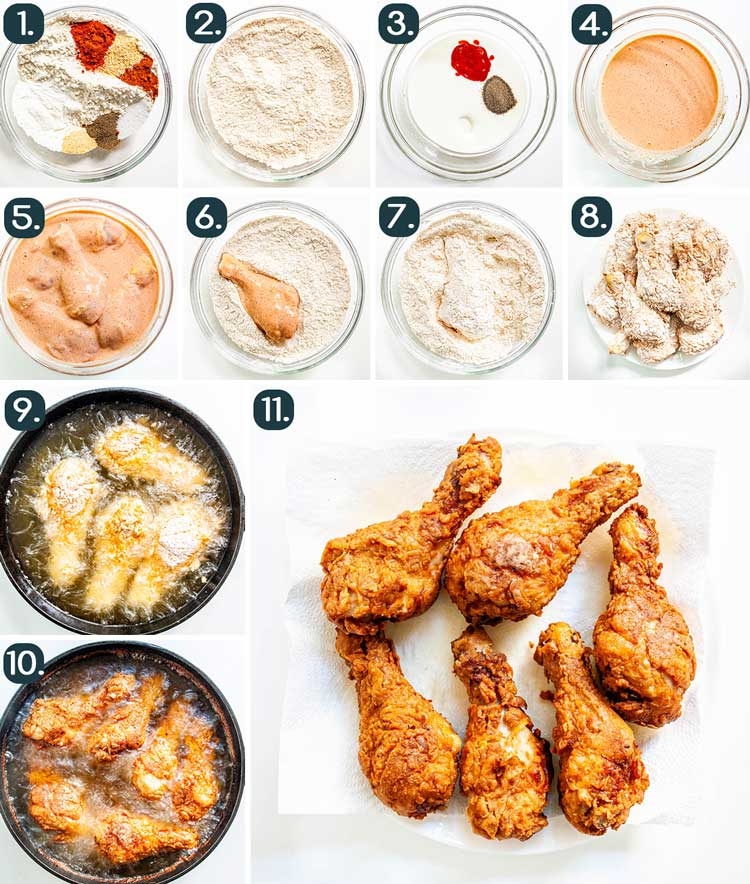Ever wondered how to know fried chicken is done without overcooking or undercooking it? Well, you're not alone. Millions of home cooks struggle with this question every single day. It's like trying to solve a puzzle while juggling hot oil and seasoning. But don't worry, because we’ve got your back. This guide will teach you everything you need to know to achieve that perfect, golden-brown fried chicken every time.
Let's face it, fried chicken is more than just food—it’s an experience. Whether you're frying it for a family gathering, a weekend dinner, or just because you're craving something delicious, knowing when it's done can make all the difference. Overcooked chicken is dry, undercooked chicken is unsafe, and no one wants soggy breading. So, buckle up, because we’re about to take you on a deep dive into the world of fried chicken.
Before we dive into the nitty-gritty, let’s talk about why this matters. Cooking fried chicken isn’t rocket science, but it does require some finesse. By the end of this guide, you’ll have the confidence to fry up a storm like a pro. Plus, you’ll impress your friends and family with perfectly cooked chicken every single time. Now, let’s get started!
Read also:Who Is Jesse Hutch Married To The Untold Story
Here's the deal: knowing how to know fried chicken is done isn't just about timing—it's about technique, temperature, and a little bit of magic. Let's break it down step by step.
Table of Contents
- Why Timing Alone Won’t Cut It
- The Role of Temperature in Perfectly Fried Chicken
- Key Indicators of Doneness
- Common Mistakes to Avoid
- How to Know Fried Chicken is Done Using a Meat Thermometer
- Tips for Achieving the Perfect Crispy Breading
- Understanding Oil Types and Their Impact on Cooking
- Fried Chicken Safety: Is It Really Done?
- How Long Should You Fry Chicken?
- Final Thoughts on How to Know Fried Chicken is Done
Why Timing Alone Won’t Cut It
Okay, so you’ve probably heard that frying chicken for 12-15 minutes is the golden rule. While timing is important, relying solely on it can lead to disaster. Different cuts of chicken cook at different rates, and the size of the pieces also plays a role. Plus, the type of oil you use, the temperature of the oil, and even the altitude where you live can affect cooking times.
Think of it this way: frying chicken is like baking a cake. You wouldn’t just set a timer and hope for the best, right? You check for doneness using multiple indicators. The same applies here. Timing is a guideline, but it’s not the be-all and end-all.
The Role of Temperature in Perfectly Fried Chicken
Temperature is where the magic happens. The ideal oil temperature for frying chicken is between 350°F and 375°F (175°C to 190°C). Why this range? Because it strikes the perfect balance between cooking the chicken thoroughly and achieving that crispy, golden breading we all crave.
Here’s the deal: if the oil is too hot, the outside of the chicken will burn before the inside is cooked. If it’s too cool, the chicken will absorb too much oil, leaving you with soggy, greasy results. So, investing in a good deep-fry thermometer is a must. It’s like having a sixth sense in the kitchen.
Why Does Oil Temperature Fluctuate?
Oil temperature can drop when you add cold chicken to the pot. To combat this, make sure your chicken is at room temperature before frying. You can also fry smaller batches to prevent the oil from cooling down too much. Remember, consistency is key!
Read also:Is Brian Jordan Married Unveiling The Truth About The Former Mlb Stars Personal Life
Key Indicators of Doneness
So, how do you know when fried chicken is done? Here are the key indicators to look out for:
- Color: The breading should be golden brown, not dark brown or black. If it’s too dark, it’s overcooked.
- Texture: The breading should be crispy, not soggy. A good test is to tap the chicken lightly with a fork. If it feels firm and doesn’t squish, it’s a good sign.
- Juiciness: Cut into a piece and check the juices. They should run clear, not pink. Pink juices mean the chicken is undercooked.
But wait, there’s more! These visual cues are great, but they’re not foolproof. That’s why we recommend using a meat thermometer for the ultimate accuracy.
Common Mistakes to Avoid
Let’s talk about the mistakes that could ruin your fried chicken experience:
- Not Preheating the Oil: Frying without preheating the oil can lead to uneven cooking and soggy results.
- Overcrowding the Pan: Frying too many pieces at once lowers the oil temperature, which can cause the chicken to absorb more oil.
- Not Patting the Chicken Dry: Excess moisture on the chicken can cause the oil to splatter and prevent the breading from crisping up.
These mistakes might seem small, but they can make a huge difference in the final result. Trust us, you don’t want to skip these steps.
How to Know Fried Chicken is Done Using a Meat Thermometer
Here’s the ultimate way to know fried chicken is done: use a meat thermometer. The USDA recommends cooking chicken to an internal temperature of 165°F (74°C). This ensures that the chicken is safe to eat and fully cooked.
But how do you use a meat thermometer? It’s simple:
- Insert the thermometer into the thickest part of the chicken, avoiding the bone.
- Check the temperature. If it’s 165°F or higher, it’s done.
- If it’s lower, keep frying and check again in a few minutes.
Using a thermometer takes the guesswork out of frying chicken. Plus, it’s super easy to use once you get the hang of it.
Tips for Achieving the Perfect Crispy Breading
Let’s talk about the breading, because let’s be real, that’s what makes fried chicken so irresistible. Here are some tips for achieving that perfect crispy coating:
- Use a Buttermilk Marinade: Soaking chicken in buttermilk overnight adds flavor and helps the breading stick better.
- Double Coat the Chicken: Dip the chicken in buttermilk, coat it in flour, dip it again in buttermilk, and then coat it in flour again. This creates a thicker, crunchier layer.
- Let It Rest: After coating the chicken, let it rest for 15-30 minutes. This allows the breading to set and prevents it from falling off during frying.
These tips might seem like extra work, but trust us, they’re worth it. Crispy breading is the cherry on top of a perfectly fried chicken experience.
What About Seasoning?
Seasoning is where you can get creative. Some people like a simple salt and pepper mix, while others go all out with paprika, garlic powder, and cayenne pepper. The key is to find a seasoning blend that suits your taste buds. Experiment until you find your perfect combination.
Understanding Oil Types and Their Impact on Cooking
Not all oils are created equal when it comes to frying chicken. Here are some popular options:
- Peanut Oil: Known for its high smoke point and neutral flavor, peanut oil is a favorite among fried chicken enthusiasts.
- Vegetable Oil: Another popular choice, vegetable oil has a high smoke point and a mild flavor.
- Canola Oil: Canola oil is a healthier option with a lower fat content, but it still delivers great results.
The type of oil you use can affect the flavor and texture of your fried chicken. Experiment with different oils to see which one you prefer.
Fried Chicken Safety: Is It Really Done?
Food safety is no joke, especially when it comes to chicken. Undercooked chicken can harbor harmful bacteria like Salmonella and Campylobacter, which can cause foodborne illnesses. That’s why it’s crucial to ensure your chicken is fully cooked before serving.
Here’s how to stay safe:
- Always use a meat thermometer to check the internal temperature.
- Don’t rely on visual cues alone.
- Wash your hands and utensils thoroughly after handling raw chicken.
By following these safety tips, you can enjoy your fried chicken without worrying about getting sick.
How Long Should You Fry Chicken?
Now, let’s talk about frying times. As we mentioned earlier, timing isn’t the only factor, but it’s still important. Here’s a rough guide for frying different cuts of chicken:
- Chicken Thighs: 12-15 minutes
- Chicken Drumsticks: 10-12 minutes
- Chicken Breasts: 12-14 minutes
- Chicken Wings: 8-10 minutes
Remember, these are just guidelines. Always check the internal temperature to ensure doneness.
Final Thoughts on How to Know Fried Chicken is Done
In conclusion, knowing how to know fried chicken is done involves a combination of timing, temperature, and visual cues. By using a meat thermometer, understanding oil temperatures, and following safety guidelines, you can achieve perfectly cooked fried chicken every time.
We encourage you to experiment with different techniques and seasoning blends to find what works best for you. And don’t forget to share your results with friends and family—they’ll be amazed by your newfound frying skills!
So, what are you waiting for? Grab some chicken, fire up the fryer, and get ready to create some magic in the kitchen. Happy frying, and don’t forget to leave a comment below with your favorite fried chicken tips!


